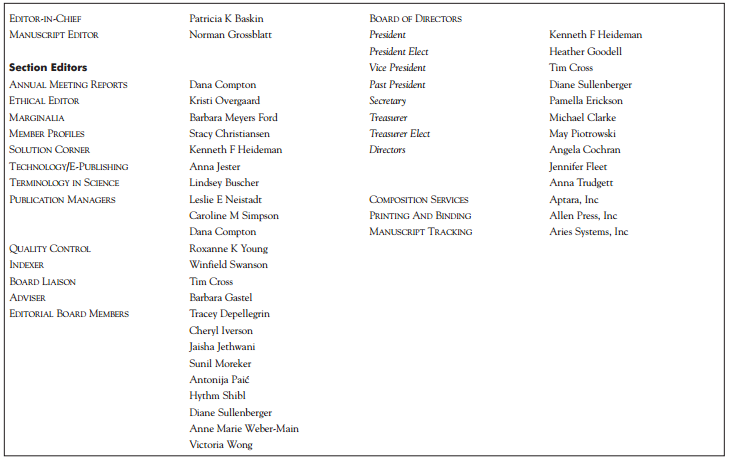In this issue of Science Editor, you’ll find a number of articles related to publication ethics. Most editors—including editors-in-chief and their associate editors, staff editors, and freelance manuscript editors— face occasional ethics issues when publishing scientific research papers. The issues range from incidents of outright fraud to less serious breaches of publication ethics, all of which detract from the integrity of the published scientific literature. The repercussions of violating publication ethics are numerous, including incorrect attribution of authorship, risk of copyright infringement, waste of research dollars, and even inappropriate medical treatment of patients. Clearly, prevention of scientific misconduct or breaches of publication ethics and appropriate handling of ensuing situations are serious concerns in any editorial office.
CSE White Paper on Promoting Integrity in Scientific Journal Publications
Spring 2012 saw the release of the latest update of the CSE White Paper on Promoting Integrity in Scientific Journal Publications. CSE presented its first full-day Short Course on Publication Ethics based on the concepts presented in the white paper, which has two major sections: the first addresses the responsibility of all who are involved in a research study—including editors, authors, reviewers, and sponsors—and the second provides information on identifying research misconduct and presents guidelines for action when misconduct occurs.
Each section of the white paper contains a number of subsections:
Responsibility of participants in the research process. For editors, topics addressed include confidentiality; conflicts of interest of all those involved; corrections, errata, and expressions of concern; authorship disputes; and allegations or findings of misconduct. The author subsection reviews authorship criteria and contributorship models, acknowledgments, author order, and changes in the author byline. The reviewer subsection deals with reviewer selection, examples of impropriety, and models of anonymity (blind, double-blind, and open). The sponsor subsection includes discussion of publication planning by sponsors, assignment of authorship, disclosure of conflicts of interest, access to data, and clinical-trial registration requirements.
Identification of research misconduct and guidelines for action. The first subsection of the second section provides descriptions of actions that constitute research misconduct: mistreatment of research subjects, falsification and fabrication of data, and piracy or plagiarism. The next subsection discusses investigations of misconduct by various international bodies, and the following one addresses responsibility for reporting suspect manuscripts. Misconduct in digital imaging, correcting the literature, and handling media inquiries about misconduct make up the final subsections of the white paper.
We encourage CSE members to use the white paper as a supplement to the statements or policies of their own publications. Many of us consult the white paper first when sticky problems arise and an answer is needed quickly.
How the Editorial Office Can Help to Prevent Misconduct and Breaches in Publication Ethics
In addition to following their own publications’ policy statements, editorial staff can access many resources that are available, a number of which are listed at the end of this article. Information provided to authors and reviewers should include statements requiring authors to confirm the following in submitting papers: that research studies were approved by institutional review boards, confidentiality of patients was maintained and patients’ consents to disclose were obtained, works are original, authors take responsibility for data in articles, authorship criteria were adhered to (no ghostwriting or guest authorship!), and disclosure of conflicts of interest were made by authors, reviewers, and editors. We can ask for standardization of reporting by our authors, using reporting guidelines—such as CONSORT, STARD, and others curated on the EQUATOR site for health research— to prevent misconduct. We should also present clear definitions of scientific misconduct and breaches of publication ethics for authors and reviewers and indicate that violations may have serious consequences.
In addition to consulting the white paper and other professional resources, such as the Committee on Publication Ethics (COPE) flowcharts, we are fortunate to be able to network with other CSE members at the annual meetings, hear presentations at the meetings, and read the advice of fellow members. The articles related to publication ethics in this issue include the following topics:
- Summary of CSE misconduct surveys.
- Detection and prevention of image manipulation.
- Detection and prevention of plagiarism with iThenticate software.
- History of COPE and the COPE resources.
- Using instructions for authors to demystify misconduct issues.
- Knowing why and when to make corrections in the literature.
- Profile of a CSE member who is the publications ethics manager for a scientific society.
- Ethical Editor column on research misconduct in clinical trials.
Prevention of problems is the common theme in most of those articles. Our hope is that use of the information provided by both the white paper and CSE members will help us to minimize problems involving publication ethics and to deal with them more effectively when they appear.
Resources
- COPE (http://publicationethics.org/) and COPE Flowcharts (http://publicationethics.org/resources/flowcharts).
- CSE White Paper on Promoting Integrity in Scientific Journal Publications (www.councilscienceeditors.org/i4a/pages/index.cfm?pageid=3313).
- EQUATOR Network (reporting guidelines) (www.equator-network.org/).
- Ethics Collaborative Online Research Environment (CORE) (nationalethicscenter.org/).
- International Committee of Medical Journal Editors (www.icmje.org/).
- US Office of Research Integrity (http://healthfinder.gov/orgs/HR2971.htm).
- World Association of Medical Editors (www.wame.org/).
PATRICIA K BASKIN is executive editor of Neurology® and Neurology® Clinical Practice and editor-in-chief of Science Editor.

